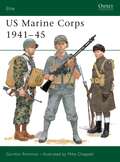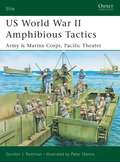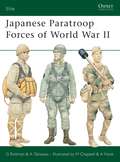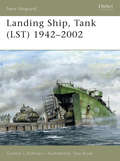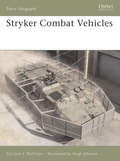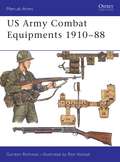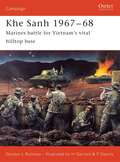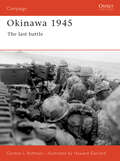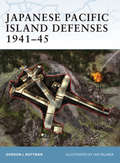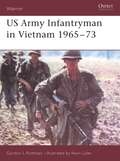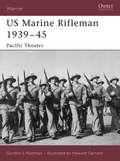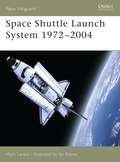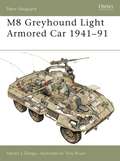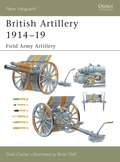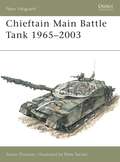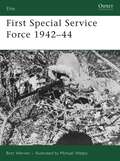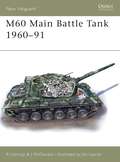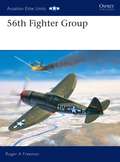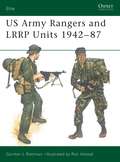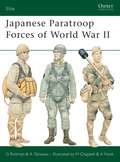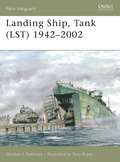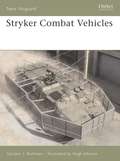- Table View
- List View
US Marine Corps 1941–45 (Elite #59)
by Gordon L. RottmanWhile the US Marine Corps was one of the smallest of American armed services in World War II, its contribution to the final victory cannot be overstated. The US Marine Corps may have only comprised 5 percent of America's armed forces, but it suffered 10 percent of all World War II combat casualties. Above all, he amphibious nature of the war in the Pacific imposed on the Marine Corps greater tasks than any it had ever before been called upon to perform. This title details the organization, weapons and equipment of the US Marines of World War II.
US World War II Amphibious Tactics: Army & Marine Corps, Pacific Theater (Elite #117)
by Peter Dennis Gordon L. RottmanThe US armed forces were responsible for many tactical innovations during the years 1941–45, but in no field was US mastery more complete than amphibious warfare. In the vast, almost empty battlefield of the Pacific the US Navy and Marine Corps were obliged to develop every aspect of the amphibious assault landing in painstaking detail, from the design of many new types of vessel, down to the tactics of the rifle platoon hitting the beach, and the logistic system without which they could not have fought their way inland. This fascinating study offers a clear, succinct explanation of every phase of these operations as they evolved during the war years, illustrated with detailed color plates and photographs.
Japanese Paratroop Forces of World War II (Elite #127)
by Adam Hook Gordon L. Rottman Richard Hook Mike Chappell Akira TakizawaFor the first time in English, this book offers a concise but fact-packed account of the organization, equipment, and all operations of Japan's small but elite wartime parachute forces. Correcting and amplifying previous accounts based on wartime intelligence, it traces the Imperial Army's Raiding Regiments and the Imperial Navy's parachute-trained Yokosuka 1st & 3rd Special Naval Landing Forces from the first trials units, through their successful assaults in early 1942, to the last desperate battles and raids of 1944–45. Thetext is illustrated with rare photographs, and meticulouslyreconstructed color artworkof the men and their gear.
Landing Ship, Tank (New Vanguard #115)
by Tony Bryan Gordon L. RottmanThe Landing Ship Tank (LST) is one of the most famous of the many World War II amphibious warfare ships. Capable of discharging its cargo directly on to shore and extracting itself, the LST provided the backbone of all Allied landings between 1943 and 1945, notably during the D-Day invasion. Through its history, the LST saw service from late 1942 until late 2002, when the US Navy decommissioned the USS Frederick (LST-1184), the last ship of its type. This book reveals the development and use of the LST, including its excellence beyond its initial design expectations.
Stryker Combat Vehicles (New Vanguard #121)
by Hugh Johnson Gordon L. RottmanThe eight-wheeled (8x8) Stryker combat light armored vehicle was adopted by the US Army in 2002 to provide a comparatively rapidly deployable contingency force with armor protection, tactical mobility, and heavy firepower, as well as advanced command, control communications, computer, intelligence, surveillance, and reconnaissance (C4ISR) capabilities. Covering the first new US Army release since the M1 Abrams MBT, this book details the conception, ongoing development and deployment of one of the most highly anticipated new AFVs in recent years, including its service in Iraq and the ensuing controversy surrounding the Stryker's varying successes.
US Army Combat Equipments 1910–88 (Men-at-Arms #205)
by Gordon L. Rottman Ronald VolstadWhether referred to as web gear, TE-21, TA50, LBE or LCE, the American soldier's individual combat equipment was seldom praised – except by its developers. Nevertheless, it has always been, and will continue to be an essential part of the fighting man's burden. With the aid of plenty of contemporary photographs, diagrams, and eight full page colour plates by Osprey veteran Ron Volstad, Gordon Rottman's text unearths a wealth of information on the changing nature of US combat equipments from 1910-1988.
Khe Sanh 1967–68: Marines battle for Vietnam’s vital hilltop base (Campaign)
by Gordon L. RottmanKhe Sanh was a small village in northwest South Vietnam that sat astride key North Vietnamese infiltration routes. In September 1966 a Marine battalion deployed into the area. Action gradually increased as the NVA attempted to destroy Free World Forces bases, and the siege of Khe Sanh proper began in October 1967. The bitter fight lasted into July 1968 when, with the changing strategic and tactical situation, the base was finally closed. This book details the siege and explains how, although the NVA successfully overran a Special Forces camp nearby, it was unable to drive US forces from Khe Sanh.
Okinawa 1945: The last battle (Campaign #96)
by Gordon L. RottmanBy the spring of 1945 the Allies were sweeping all before them in the Pacific War against Japan, and a series of victories had reclaimed many of the islands and territories seized by the Imperial Japanese forces in the early months of the war. The dark days of humiliating defeat were far behind the unstoppable Allied juggernaut victory was now assured. The question was where the last battle would be fought. That place was the island of Okinawa. This book details the struggle for the island as US Marines and Army units battled determined Japanese defenders in the last battle of World War II.
Japanese Pacific Island Defenses 1941–45 (Fortress #1)
by Gordon L. Rottman Ian PalmerThe prolonged and bloody fighting for control of the Japanese occupied Pacific islands in World War II is a key point in 20th-century warfare. No two islands were alike in the systems and nature of their defensive emplacements, and local improvization and command preferences affected both materials used and defensive models. This title details the establishment, construction and effectiveness of Japanese temporary and semi-permanent crew-served weapons positions and individual and small-unit fighting positions. Integrated obstacles and minefields, camouflage and the changing defensive principles are also covered.
US Army Infantryman in Vietnam 1965–73 (Warrior)
by Gordon L. Rottman Kevin LylesThis book tells the compelling story of the average US infantryman in Vietnam. Beginning with conscription, enlistment, Basic Training, and Advanced Individual Training at the Armed Forces Induction Center at Fort Polk (the infamous "Tigerland†?), it goes on to explore the day-to-day realities of service in Vietnam, from routine tasks at the firebase to search-and-destroy missions, rocket attacks, and firefights in the field. Weaponry, clothing, and equipment are all described and shown in detailed color plates. A vivid picture of the unique culture and experiences of these soldiers emerges – from their vernacular to the prospect of returning to an indifferent, if not hostile, homeland.
US Marine Rifleman 1939–45: Pacific Theater (Warrior #112)
by Howard Gerrard Gordon L. RottmanThe Marine Corps began World War II with less than 66,000 officers and men. Yet despite suffering 10 per cent of the overall American casualties, the Marines were able to build on their proud traditions and history to transform a small branch of service into a premier combined arms amphibious assault force. Regardless of its expansion by 750 percent, the Corps was able to maintain its sense of tradition, instill that into thousands of new Marines, and create an elite arm of service. In this book, Gordon Rottman, follows a Marine Corps rifleman through his draft, training and participation in assaults such as: Roi-Namur in the Marshall Islands, Saipan and Tinian in the Mariana Islands, and Iwo Jima.
Space Shuttle Launch System 1972–2004 (New Vanguard)
by Ian Palmer Mark LardasThe Space Shuttle is one of the oldest and most famous manned launch systems – the only launch vehicle that has been used for a longer period of time is the Soviet (now Russian) R-7 booster. By the start of the third millennium, the Space Shuttle had carried crews into space over 85 times. Although not a military structure, the Shuttle had been sold as an all-purpose launch system to be used jointly for military and civilian purposes. Featuring full-colour photos throughout, this book covers the design, development and operational history of a unique vehicle.
M8 Greyhound Light Armored Car 1941–91 (New Vanguard)
by Steven J. Zaloga Tony BryanThe M8 light armored car was the only significant wheeled combat vehicle used by the US Army in World War II. In conjunction with the lightly armed utility version, the M20, it was the staple of the army's cavalry squadrons for use in reconnaissance and scouting. First entering combat in Italy in 1943, it was widely used throughout the campaign in northwest Europe, though its off-road performance was found to be wanting. This title describes the design and development of the M8, covering the many variants that were produced during World War II and afterwards, along with a comprehensive survey of its operational use.
French Warship Crews 1789–1805: From the French Revolution to Trafalgar (Warrior)
by Steve Noon Terry CrowdyThis book gives a detailed and authentic account of the life and experiences of French warship crews from the Revolution up to Trafalgar. It describes the recruitment and composition of crews, the different duties performed and the living conditions they had to endure at sea. Their experiences of fighting the British are covered in depth; from preparing the ship for action, to the violent discharges of heavy calibre guns, the often gruesome realities of sea warfare are revealed through pictures and contemporary testimonies.
British Artillery 1914–19: Field Army Artillery (New Vanguard)
by Brian Delf Dale ClarkeIn 1914 the artillery of Britain's 'Field Army' encompassed those weapons judged to have sufficient mobility to keep up with troops in the field. This book describes all major variants, from the 60-pdr guns of the heavy field batteries, perched somewhat uncomfortably on the cusp between field artillery and siege artillery, to the 2.75in. guns of the mountain batteries, almost toy-like in comparison. Between these two extremes lay the bulk of the artillery of the Field Army: the 13-pdr guns of the Royal Horse Artillery, and the 18-pdr guns and 4.5in. howitzers of the Royal Field Artillery batteries.
Chieftain Main Battle Tank 1965–2003 (New Vanguard)
by Peter Sarson Simon DunstanThe concept of the Main Battle Tank emerged from the Centurion Universal tank that was developed at the end of World War II. Development of its successor began as early as 1951. The Chieftain incorporated significant innovations including a reclining driver position and two-piece ammunition for greater survivability. The tank entered service in 1967 and was the heaviest armed and armoured MBT within the NATO alliance. The Chieftain saw combat during the Iran-Iraq War, with the Kuwaitis during the 1990 Iraqi invasion and with the British Army during the Gulf War of 1990–91 as special-purpose variants. This book explores the design, development and operation of one of the most influential vehicles used in modern warfare.
First Special Service Force 1942–44 (Elite)
by Michael Welply Bret WernerThis is a concise history of the unique integrated commando-style brigade of US and Canadian volunteers formed in 1942. Hand picked, and trained in airborne, amphibious, mountain and winter warfare, demolitions and close-quarter tactics, they left a combat legacy still recognized amongst today's Special Forces. This book explores the remarkable results the FSSF achieved in Italy in the harsh mountain fighting on the Winter Line, in the trenches of Anzio, and in the breakthrough to Rome. Accompanied by unique combat photography and illustrations of their distinctive uniforms, this is an insight into a famous, but little explored unit.
M60 Main Battle Tank 1960–91 (New Vanguard #85)
by Jim Laurier Richard Lathrop John McDonaldEntering service in the early 1960s, the M60 tank was in production for 23 years and formed the backbone of US Army and Marine armoured units during the Cold War. Over 15,000 were built in four basic models: the M60, M60A1, M60A2, and the M60A3. Although the M60 had been phased out of US Army service by the time Iraq invaded Kuwait in 1990, M60s were amongst the first Allied tanks to enter Kuwait City with the US Marines. This book examines the design and deployment of the M60, a very widely used vehicle that is still in service today.
56th Fighter Group (Aviation Elite Units #2)
by Chris Davey Roger FreemanOne of the first Thunderbolt groups to see action in the European Theatre of Operations (ETO) with the US Army Air Forces, the 56th Fighter Group (FG) was also the only fighter unit within the Eighth Air Force to remain equipped with the mighty P-47 until war's end. Led by the inspirational 'Hub' Zemke, this group was responsible for devising many of the bomber escort tactics employed by VIII Fighter Command between 1943 and 1945. By VE-Day the 56th FG had shot down 100 more enemy aircraft than any other group in the Eighth Air Force, its pilots being credited with 677 kills during 447 missions. The exploits of this elite fighter unit are detailed in this volume together with photographs, their aircraft profiles and insignia.
US Army Rangers & LRRP Units 1942–87 (Elite)
by Gordon L. Rottman Ronald VolstadRanger the very word conjures up visions of small, highly trained units executing lightning-fast raids on an unexpecting enemy. It is also synonymous with high esprit de corps and excellence at arms. The US Army Rangers provide units of well-disciplined soldiers who possess the knowledge and courage to operate on their own, deep behind enemy lines. Gordon L. Rottman explores the history of these unique troops, starting with the original 'Rogers' Rangers' company of 1756, whose daring operations and deep penetrations of enemy-held country laid down the pattern for all subsequent Ranger units to follow.
US Marine Corps 1941–45 (Elite)
by Gordon L. Rottman Mike ChappellWhile the US Marine Corps was one of the smallest of American armed services in World War II, its contribution to the final victory cannot be overstated. The US Marine Corps may have only comprised 5 percent of America's armed forces, but it suffered 10 percent of all World War II combat casualties. Above all, he amphibious nature of the war in the Pacific imposed on the Marine Corps greater tasks than any it had ever before been called upon to perform. This title details the organization, weapons and equipment of the US Marines of World War II.
US World War II Amphibious Tactics: Army & Marine Corps, Pacific Theater (Elite)
by Peter Dennis Gordon L. RottmanThe US armed forces were responsible for many tactical innovations during the years 1941–45, but in no field was US mastery more complete than amphibious warfare. In the vast, almost empty battlefield of the Pacific the US Navy and Marine Corps were obliged to develop every aspect of the amphibious assault landing in painstaking detail, from the design of many new types of vessel, down to the tactics of the rifle platoon hitting the beach, and the logistic system without which they could not have fought their way inland. This fascinating study offers a clear, succinct explanation of every phase of these operations as they evolved during the war years, illustrated with detailed color plates and photographs.
Japanese Paratroop Forces of World War II (Elite #127)
by Adam Hook Gordon L. Rottman Richard Hook Mike Chappell Akira TakizawaFor the first time in English, this book offers a concise but fact-packed account of the organization, equipment, and all operations of Japan's small but elite wartime parachute forces. Correcting and amplifying previous accounts based on wartime intelligence, it traces the Imperial Army's Raiding Regiments and the Imperial Navy's parachute-trained Yokosuka 1st & 3rd Special Naval Landing Forces from the first trials units, through their successful assaults in early 1942, to the last desperate battles and raids of 1944–45. Thetext is illustrated with rare photographs, and meticulouslyreconstructed color artworkof the men and their gear.
Landing Ship, Tank (New Vanguard)
by Tony Bryan Gordon L. RottmanThe Landing Ship Tank (LST) is one of the most famous of the many World War II amphibious warfare ships. Capable of discharging its cargo directly on to shore and extracting itself, the LST provided the backbone of all Allied landings between 1943 and 1945, notably during the D-Day invasion. Through its history, the LST saw service from late 1942 until late 2002, when the US Navy decommissioned the USS Frederick (LST-1184), the last ship of its type. This book reveals the development and use of the LST, including its excellence beyond its initial design expectations.
Stryker Combat Vehicles (New Vanguard #121)
by Hugh Johnson Gordon L. RottmanThe eight-wheeled (8x8) Stryker combat light armored vehicle was adopted by the US Army in 2002 to provide a comparatively rapidly deployable contingency force with armor protection, tactical mobility, and heavy firepower, as well as advanced command, control communications, computer, intelligence, surveillance, and reconnaissance (C4ISR) capabilities. Covering the first new US Army release since the M1 Abrams MBT, this book details the conception, ongoing development and deployment of one of the most highly anticipated new AFVs in recent years, including its service in Iraq and the ensuing controversy surrounding the Stryker's varying successes.
